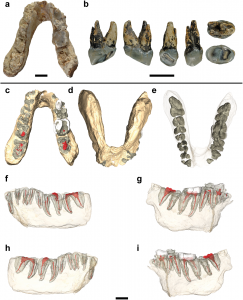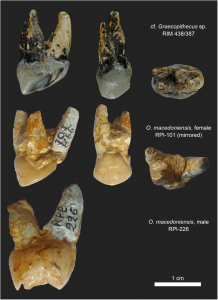A new discovery shows that mankind was actually born in Europe and not in Africa, as previously thought
Scientists found that the birthplace of mankind was actually Europe, and not Africa, as it was known until now.
A new research published in the journal PLOS One changes the history of human evolution. While until now most experts believed that, around seven million years ago, our human lineage split from apes in central Africa, where hominids remained for the next five million years before venturing further afield, the discovery of two fossils changes everything we knew. These fossils of an ape-like creature which had human-like teeth have been found in Bulgaria and Greece and are dating 7.24 million years ago.
Scientists believe that at that time climate change had turned Eastern Europe into an open savannah and forced apes to find new food sources, and this led to a shift towards bipedalism.
The creature, named Graecopithecus freybergi, and nicknameded by scientists ‘El Graeco’, proves our ancestors were already starting to evolve in Europe 200,000 years before the earliest African hominid, The Telegraph reports.
By placing the last common ancestor of both chimpanzees and humans – the so-called Missing Link – in the Mediterranean region, the findings entirely change the beginning of human history, according to researchers.
“This study changes the ideas related to the knowledge about the time and the place of the first steps of the humankind. Graecopithecus is not an ape. He is a member of the tribe of hominins and the direct ancestor of homo,” said Professor Nikolai Spassov from the Bulgarian Academy of Sciences.

“The food of the Graecopithecus was related to the rather dry and hard savannah vegetation, unlike that of the recent great apes which are living in forests. Therefore, like humans, he has wide molars and thick enamel”.
Computer tomography revealed the internal structures of the fossils and that the roots of premolars are widely fused. The lower jaw has also additional dental root features, which suggests that the species was a hominid.
“While great apes typically have two or three separate and diverging roots, the roots of Graecopithecus converge and are partially fused – a feature that is characteristic of modern humans, early humans and several pre-humans,”, said lead researcher Professor Madelaine Böhme of the University of Tübingen.

“To some extent this is a newly discovered missing link. But missing links will always exist, because evolution is infinite chain of subsequent forms. Probably El Graeco’s face will resemble a great ape, with shorter canines,” Spassov added.
The oldest African hominid, Sahelanthropus tchadensis, which was found in Chad, is several hundred thousand years younger than the new species found.
“We were surprised by our results, as pre-humans were previously known only from sub-Saharan Africa,” said doctoral student Jochen Fuss, a Tübingen PhD student who conducted this part of the study.
“This dating allows us to move the human-chimpanzee split into the Mediterranean area,” said also Professor David Begun, a University of Toronto paleoanthropologist and co-author of this study.
“Our findings may eventually change our ideas about the origin of humanity. I personally don’t think that the descendants of Graecopithecus die out, they may have spread to Africa later. The split of chimps and humans was a single event. Our data support the view that this split was happening in the eastern Mediterranean – not in Africa. If accepted, this theory will indeed alter the very beginning of human history,” Professor Böhme added.
Still, some experts are skeptical about the findings. “It is possible that the human lineage originated in Europe, but very substantial fossil evidence places the origin in Africa, including several partial skeletons and skulls. I would be hesitant about using a single character from an isolated fossil to set against the evidence from Africa,” said retired anthropologist and author Dr Peter Andrews, formerly at the Natural History Museum in London.